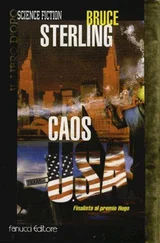Bruce Sterling - The Hacker Crackdown
Здесь есть возможность читать онлайн «Bruce Sterling - The Hacker Crackdown» весь текст электронной книги совершенно бесплатно (целиком полную версию без сокращений). В некоторых случаях можно слушать аудио, скачать через торрент в формате fb2 и присутствует краткое содержание. Жанр: Фантастика и фэнтези, на английском языке. Описание произведения, (предисловие) а так же отзывы посетителей доступны на портале библиотеки ЛибКат.
- Название:The Hacker Crackdown
- Автор:
- Жанр:
- Год:неизвестен
- ISBN:нет данных
- Рейтинг книги:4 / 5. Голосов: 1
-
Избранное:Добавить в избранное
- Отзывы:
-
Ваша оценка:
- 80
- 1
- 2
- 3
- 4
- 5
The Hacker Crackdown: краткое содержание, описание и аннотация
Предлагаем к чтению аннотацию, описание, краткое содержание или предисловие (зависит от того, что написал сам автор книги «The Hacker Crackdown»). Если вы не нашли необходимую информацию о книге — напишите в комментариях, мы постараемся отыскать её.
The Hacker Crackdown — читать онлайн бесплатно полную книгу (весь текст) целиком
Ниже представлен текст книги, разбитый по страницам. Система сохранения места последней прочитанной страницы, позволяет с удобством читать онлайн бесплатно книгу «The Hacker Crackdown», без необходимости каждый раз заново искать на чём Вы остановились. Поставьте закладку, и сможете в любой момент перейти на страницу, на которой закончили чтение.
Интервал:
Закладка:
The headquarters of the Electronic Frontier Foundation is on 155 Second Street in Cambridge, a Bostonian suburb north of the River Charles. Second Street has weedy sidewalks of dented, sagging brick and elderly cracked asphalt; large street-signs warn "NO PARKING DURING DECLARED SNOW EMERGENCY." This is an old area of modest manufacturing industries; the EFF is catecorner from the Greene Rubber Company. EFF's building is two stories of red brick; its large wooden windows feature gracefully arched tops and stone sills.
The glass window beside the Second Street entrance bears three sheets of neatly laser-printed paper, taped against the glass. They read: ON Technology. EFF. KEI.
"ON Technology" is Kapor's software company, which currently specializes in "groupware" for the Apple Macintosh computer. "Groupware" is intended to promote efficient social interaction among office-workers linked by computers. ON Technology's most successful software products to date are "Meeting Maker" and "Instant Update."
"KEI" is Kapor Enterprises Inc., Kapor's personal holding company, the commercial entity that formally controls his extensive investments in other hardware and software corporations.
"EFF" is a political action group -- of a special sort.
Inside, someone's bike has been chained to the handrails of a modest flight of stairs. A wall of modish glass brick separates this anteroom from the offices. Beyond the brick, there's an alarm system mounted on the wall, a sleek, complex little number that resembles a cross between a thermostat and a CD player. Piled against the wall are box after box of a recent special issue of *Scientific American,* "How to Work, Play, and Thrive in Cyberspace," with extensive coverage of electronic networking techniques and political issues, including an article by Kapor himself. These boxes are addressed to Gerard Van der Leun, EFF's Director of Communications, who will shortly mail those magazines to every member of the EFF.
The joint headquarters of EFF, KEI, and ON Technology, which Kapor currently rents, is a modestly bustling place. It's very much the same physical size as Steve Jackson's gaming company. It's certainly a far cry from the gigantic gray steel-sided railway shipping barn, on the Monsignor O'Brien Highway, that is owned by Lotus Development Corporation.
Lotus is, of course, the software giant that Mitchell Kapor founded in the late 70s. The software program Kapor co-authored, "Lotus 1-2-3," is still that company's most profitable product. "Lotus 1-2-3" also bears a singular distinction in the digital underground: it's probably the most pirated piece of application software in world history.
Kapor greets me cordially in his own office, down a hall. Kapor, whose name is pronounced KAY-por, is in his early forties, married and the father of two. He has a round face, high forehead, straight nose, a slightly tousled mop of black hair peppered with gray. His large brown eyes are wideset, reflective, one might almost say soulful. He disdains ties, and commonly wears Hawaiian shirts and tropical prints, not so much garish as simply cheerful and just that little bit anomalous.
There is just the whiff of hacker brimstone about Mitch Kapor. He may not have the hard-riding, hell-for- leather, guitar-strumming charisma of his Wyoming colleague John Perry Barlow, but there's something about the guy that still stops one short. He has the air of the Eastern city dude in the bowler hat, the dreamy, Longfellow-quoting poker shark who only *happens* to know the exact mathematical odds against drawing to an inside straight. Even among his computer-community colleagues, who are hardly known for mental sluggishness, Kapor strikes one forcefully as a very intelligent man. He speaks rapidly, with vigorous gestures, his Boston accent sometimes slipping to the sharp nasal tang of his youth in Long Island.
Kapor, whose Kapor Family Foundation does much of his philanthropic work, is a strong supporter of Boston's Computer Museum. Kapor's interest in the history of his industry has brought him some remarkable curios, such as the "byte" just outside his office door. This "byte" -- eight digital bits -- has been salvaged from the wreck of an electronic computer of the pre-transistor age. It's a standing gunmetal rack about the size of a small toaster- oven: with eight slots of hand-soldered breadboarding featuring thumb-sized vacuum tubes. If it fell off a table it could easily break your foot, but it was state-of-the-art computation in the 1940s. (It would take exactly 157,184 of these primordial toasters to hold the first part of this book.)
There's also a coiling, multicolored, scaly dragon that some inspired techno-punk artist has cobbled up entirely out of transistors, capacitors, and brightly plastic-coated wiring.
Inside the office, Kapor excuses himself briefly to do a little mouse-whizzing housekeeping on his personal Macintosh IIfx. If its giant screen were an open window, an agile person could climb through it without much trouble at all. There's a coffee-cup at Kapor's elbow, a memento of his recent trip to Eastern Europe, which has a black-and-white stencilled photo and the legend CAPITALIST FOOLS TOUR. It's Kapor, Barlow, and two California venture-capitalist luminaries of their acquaintance, four windblown, grinning Baby Boomer dudes in leather jackets, boots, denim, travel bags, standing on airport tarmac somewhere behind the formerly Iron Curtain. They look as if they're having the absolute time of their lives.
Kapor is in a reminiscent mood. We talk a bit about his youth -- high school days as a "math nerd," Saturdays attending Columbia University's high-school science honors program, where he had his first experience programming computers. IBM 1620s, in 1965 and '66. "I was very interested," says Kapor, "and then I went off to college and got distracted by drugs sex and rock and roll, like anybody with half a brain would have then!" After college he was a progressive-rock DJ in Hartford, Connecticut, for a couple of years.
I ask him if he ever misses his rock and roll days -- if he ever wished he could go back to radio work.
He shakes his head flatly. "I stopped thinking about going back to be a DJ the day after Altamont."
Kapor moved to Boston in 1974 and got a job programming mainframes in COBOL. He hated it. He quit and became a teacher of transcendental meditation. (It was Kapor's long flirtation with Eastern mysticism that gave the world "Lotus.")
In 1976 Kapor went to Switzerland, where the Transcendental Meditation movement had rented a gigantic Victorian hotel in St-Moritz. It was an all-male group -- a hundred and twenty of them -- determined upon Enlightenment or Bust. Kapor had given the transcendant his best shot. He was becoming disenchanted by "the nuttiness in the organization." "They were teaching people to levitate," he says, staring at the floor. His voice drops an octave, becomes flat. "*They don't levitate.*"
Kapor chose Bust. He went back to the States and acquired a degree in counselling psychology. He worked a while in a hospital, couldn't stand that either. "My rep was," he says "a very bright kid with a lot of potential who hasn't found himself. Almost thirty. Sort of lost."
Kapor was unemployed when he bought his first personal computer -- an Apple II. He sold his stereo to raise cash and drove to New Hampshire to avoid the sales tax.
"The day after I purchased it," Kapor tells me, "I was hanging out in a computer store and I saw another guy, a man in his forties, well-dressed guy, and eavesdropped on his conversation with the salesman. He didn't know anything about computers. I'd had a year programming. And I could program in BASIC. I'd taught myself. So I went up to him, and I actually sold myself to him as a consultant." He pauses. "I don't know where I got the nerve to do this. It was uncharacteristic. I just said, 'I think I can help you, I've been listening, this is what you need to do and I think I can do it for you.' And he took me on! He was my first client! I became a computer consultant the first day after I bought the Apple II."
Читать дальшеИнтервал:
Закладка:
Похожие книги на «The Hacker Crackdown»
Представляем Вашему вниманию похожие книги на «The Hacker Crackdown» списком для выбора. Мы отобрали схожую по названию и смыслу литературу в надежде предоставить читателям больше вариантов отыскать новые, интересные, ещё непрочитанные произведения.
Обсуждение, отзывы о книге «The Hacker Crackdown» и просто собственные мнения читателей. Оставьте ваши комментарии, напишите, что Вы думаете о произведении, его смысле или главных героях. Укажите что конкретно понравилось, а что нет, и почему Вы так считаете.



